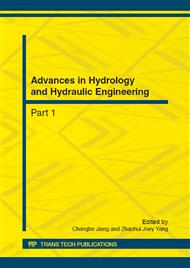p.68
p.72
p.78
p.83
p.88
p.99
p.104
p.108
p.113
Optimal Operation of Underground Reservoir in Tailan River Basin
Abstract:
Tailan river basin is a typical drought river basin in northwest China where construction of underground reservoirs is approved as an effective way to solve the problem of water resource shortage in the river basin. In order to ensure water supply efficiency of the underground reservoirs of the basin, it is necessary to research their recharge and supply patterns and to optimally operate them. This paper has, therefore, investigated different recharge locations and recharge ways through numerical simulation of underground flow in an underground reservoir area of the basin to explore a typical scheduling plan for optimal operation of the reservoir. The results show that it is better to recharge the reservoir using the flood season recharge approach at the centre of the reservoir area to ensure its continuous operation. Following from this recharge process, the use of a three-well pumping scheme is regarded as the best choice for optimal water supply from the reservoir. Also, the study indicates that for the same recharge amount, if the recharge time is closer to the pumping peak, then there is the more obvious effect of underground level recovery; the recovery is much better if the recharge time is more concentrated.
Info:
Periodical:
Pages:
88-98
Citation:
Online since:
October 2012
Price:
Сopyright:
© 2012 Trans Tech Publications Ltd. All Rights Reserved
Share:
Citation:


